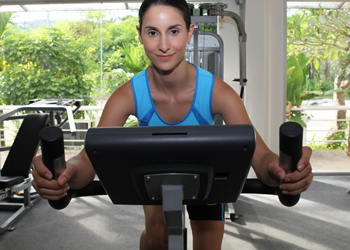 As a certified Spinning instructor, I obviously think an indoor cycling workout is a good way to stay fit (and despite often being really tough, they’re fun!) But as a triathlete, how should you approach an indoor cycling class? Is Spinning (or other indoor cycling class, such as RPM) good for your training? If you haven’t been before, what should you expect from an indoor cycling class?
As a certified Spinning instructor, I obviously think an indoor cycling workout is a good way to stay fit (and despite often being really tough, they’re fun!) But as a triathlete, how should you approach an indoor cycling class? Is Spinning (or other indoor cycling class, such as RPM) good for your training? If you haven’t been before, what should you expect from an indoor cycling class?
What to Expect
If you have never been to an indoor cycling class, don’t be intimidated. Classes can be really tough, but when it comes down to it, you are in control of your workout. Arrive to the class early and let your instructor know that you’re new (and be sure to share any injuries).
The instructor should help you to set up your bike properly and let you know how it works. As a rule, you will go through a warm-up, a variety of terrain (hills, flats, etc.) and speeds, and finish with a cool down, all accompanied by high-energy music and instructor encouragement. Because you control the tension level (or gearing ,depending on the bike), you can keep your first sessions easier if you need to until your body gets used to the new workout.
Newbie tip: bring hydration and a towel- the sessions get sweaty!
Are Indoor Cycling Classes Good for Triathletes?
Indoor cycling classes are great this time of year, when it’s often still too cold (or rainy or…) for an enjoyable session outdoors. They are also excellent for a mid-week session when it’s frankly just easier to get to your gym, or as a fun way to provide motivation during a training slump.
However, indoor cycling does NOT take the place of training outside on your bike for a few reasons:
- You are not always getting a triathlon-specific workout
- Your bike geometry is different than the one at the gym
- You are not able to practice essential skills such as cornering, drinking while moving, and balance!
That does not mean you can’t have a great session. Talk to your instructor. Tell them that you’re training for a triathlon. If there’s something that really doesn’t fit into your training plan, ask if they are okay with you going easier during a sprint section or continuing to ride after the session if it’s too short (or whatever adjustments that you need).
Try to maintain good training practices, even indoors.
Think of your form and your pedal stroke. Work on good cadence (optimal is around 80-100 rotations per minute on the flats, 60 RPM at the very lowest on hills to avoid overly straining your knees). And while your sessions can be great strength-builders and cardio training, be sure to spend plenty of time on your bike outside, at least as soon as you can tolerate the weather!
I recommend finding a class with an instructor who focuses on cycling. The best instructors, in my opinion, recreate an experience similar to riding on the road. Some instructors try to employ arm movements, push-ups, etc., on the bike – something that isn’t cycling-based, is not recommended by many indoor cycling programs, and can even be dangerous while you’re clipped or strapped into pedals. Choose the session that’s right for you, but again, be sure that it is based on good training practices.
What Kind of a Workout Will You Get?
Of course, your indoor cycling session should build your cycling fitness, however, some moves, such as running on the pedals*, will activate muscles more typically associated with running. You will gain strength and cardio conditioning.
Calorie burn can range from 400-600 calories per class, so it’s a pretty good way to burn calories if you’re counting.
And as I mentioned before, though tough, the session is fun, especially if the music and group dynamic inspire you.
Enjoy your training- indoors and out!
Coach Kristin x
* There are five core movements in the Spinning programme:
- Seated flat, with hands at the center part of the handlebars. This is hand position one. This position should be used only when seated, for flat road simulations and during the warm-up and cool down. Cadence between 80 and 110 RPM.
- Standing flat (also known as running), with hands wide on the back 12-14″ part of the handlebars that crosses the rider’s body. This is hand position two. Proper form for standing while running requires the body to be more upright and the back of the legs touching or enveloping the point of the saddle, with the center of gravity directly over the crank. The pressure of body weight should never rest excessively on the handlebars. Cadence is between 80 and 110 RPM
- Jumps, (also known as lifts), a combination of seated and standing with riders hands at position two for durations of between two and eight seconds. Cadence between 80 and 110 RPM.
- Seated climb with hands at position two, increased resistance and lower cadence of 60-80 RPM.
- Standing climb with hands wide and forward so the thumb tips are touching the far end of the handlebars (hand position three). The rider is canted slightly forward so that maximum force can be exerted onto the pedals with heavy resistance and a cadence of 60-80 RPM.
Comments are closed.